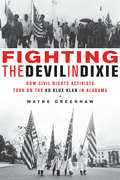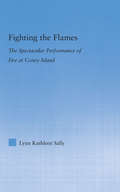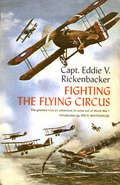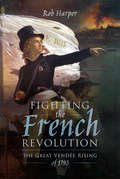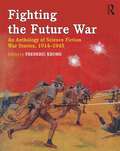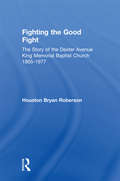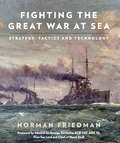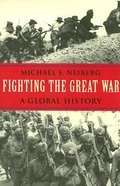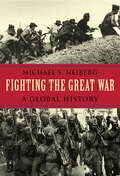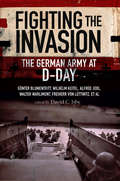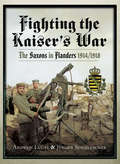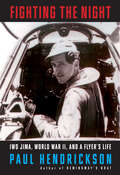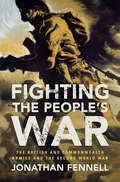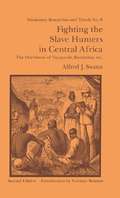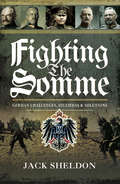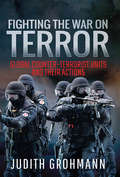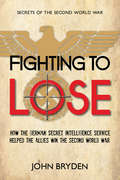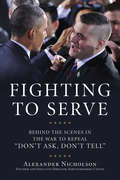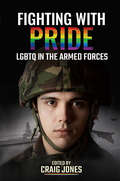- Table View
- List View
Fighting the Devil in Dixie: How Civil Rights Activists Took on the Ku Klux Klan in Alabama
by Wayne GreenhawExamining the growth of the Ku Klux Klan (KKK) following the birth of the civil rights movement, this book is filled with tales of the heroic efforts to halt their rise to power. Shortly after the success of the Montgomery bus boycott, the KKK--determined to keep segregation as the way of life in Alabama--staged a resurgence, and the strong-armed leadership of Governor George C. Wallace, who defied the new civil rights laws, empowered the Klan's most violent members. Although Wallace's power grew, not everyone accepted his unjust policies, and blacks such as Martin Luther King Jr., J. L. Chestnut, and Bernard LaFayette began fighting back in the courthouses and schoolhouses, as did young southern lawyers such as Charles "Chuck" Morgan, who became the ACLU's southern director; Morris Dees, who cofounded the Southern Poverty Law Center; and Bill Baxley, Alabama attorney general, who successfully prosecuted the bomber of Birmingham's 16th Street Baptist Church and legally halted some of Governor Wallace's agencies designed to slow down integration. Dozens of exciting, extremely well-told stories demonstrate how blacks defied violence and whites defied public ostracism and indifference in the face of kidnappings, bombings, and murders.
Fighting the Flames: The Spectacular Performance of Fire at Coney Island (Literary Criticism and Cultural Theory)
by Lynn Kathleen SallyIn Fighting the Flames, Sally contextualizes, historicizes, and theorizes the spectacular performance of fire at turn-of-the-twentieth century Coney Island. The performance of fire included staged exhibits, such as Fire and Flames and Fighting the Flames, and the real fires that plagued its history. While Coney Island placed fire center stage in its fire-based disaster spectacles, fire has continuously burned its own bridge, destroying the producer who wants to make fire the star of his show. The real conflagrations at Coney Island insert precisely what was missing from these staged performances: ephemerality, unpredictability, and newness of the present that serve as metaphors for not only fire but for the development of the metropolis and the advent of modernity.
Fighting the Flying Circus
by Captain Eddie V. RickenbackerIn Fighting the Flying Circus, Captain Rickenbacker recounts his combat missions against the Germans in the skies over Europe during WWI.
Fighting the Flying Circus
by Captain Eddie V. RickenbackerIn Fighting the Flying Circus, Captain Rickenbacker recounts his combat missions against the Germans in the skies over Europe during WWI.
Fighting the Flying Circus
by Eddie V. RickenbackerIn Fighting the Flying Circus, Captain Rickenbacker recounts his combat missions against the Germans in the skies over Europe during WWI.
Fighting the French Revolution: The Great Vendée Rising of 1793
by Rob HarperThis vivid history of late 18th century France chronicles the little-known counterrevolution that threatened the First Republic. 1793 was a year of great turmoil in France. With foreign invasion along its borders and a political war raging in Paris, a large-scale revolt suddenly erupted in the western Department of the Vendée, The Vendée Militaire almost brought the new-born French Republic to its knees. The immediate trigger for this Great War of the Vendée was the attempted imposition of conscription. But the region seethed at the erosion of its traditional values and way of life. The persecution of the Catholic Church and killing of the king symbolized to the Vendéens how dangerous the new Republic had become. In a matter of weeks tens of thousands had flocked to fight for the &‘Catholic and Royal&’ cause. This is the story of the new Republic&’s ferocious military campaigns against the armies of the Vendée, which fought a dogged battle from March to December of 1793. Napoleon later called it &‘The War of Giants&’ and it directly led to the implementation of some of the Republic&’s most extreme laws.
Fighting the Future War: An Anthology of Science Fiction War Stories, 1914-1945
by Frederic KromeThe period between World War I and World War II was one of intense change. Everything was modernizing, including our technology for making war—witness machine guns, trench warfare, biological agents, and ultimately The Final Solution. This modernization and eye toward the future was reflected in many facets of pop culture, including fashion, home-wear design, and the popular literature of the time. In sci-fi, a specific genre emerged—that of the ‘future war.’ Fred Krome has collected many of these future war stories together for the first time in Fighting the Future War. Bolstered by a comprehensive introduction, and introduced with historical information about both the authors of the stories and the historical time period, these stories provide a view into the field of pulp science fiction writing, the issues that informed the time period between the world wars, and the way people envisioned the wars of tomorrow. Revealing anxieties about society, technology, race and politics, the genre of the future war story is important material for students of history and literature.
Fighting the Good Fight: The Story of the Dexter Avenue King Memorial Baptist Church, 1865-1977
by Houston Bryan RobersonThe Dexter Avenue King Memorial Church played an important role in the Civil Rights movement-it was the backbone of the Montgomery bus boycott, which served as a model for other grassroots demonstrations and which also propelled Martin Luther King, Jr. into the national spotlight.Roberson chronicles five generations in the life of this congregation. He uses it as a lens through which to explore how the church functioned as a formative social, cultural, and political institution within a racially fractured and continually shifting cultural and civil landscape. Roberson highlights some of the prominent figures associated with the church, such as Martin Luther King, Jr., as well as some of the less prominent figures--for example the many women whose organizational efforts sustained the church.
Fighting the Great War at Sea: Strategy, Tactic and Technology
by Norman FriedmanWinner of the John Lyman Book Award for Naval and Maritime Science and Technology. &“A compelling and convincing historical analysis of World War I.&” —Navy News While the overriding image of the First World War is of the bloody stalemate on the western front, the overall shape of the war arose out of its maritime character. It was essentially a struggle about access to worldwide resources, most clearly seen in Germany&’s desperate attempts to counter the American industrial threat, which ultimately drew the United States into the war. This radical new book concentrates on the way in which each side tried to use or deny the sea to the other, and in so doing, describes rapid wartime changes not only in ship and weapons technology but also in the way naval warfare was envisaged and fought. Melding strategic, technical, and tactical aspects, Friedman approaches the First World War from a fresh perspective and demonstrates how its perceived lessons dominated the way navies prepared for the Second World War. &“Friedman is a master of the evolution of naval strategy, tactics and technology . . . a rewarding read that will leave many wanting to return again and again just to see what they might have missed the first time.&” —Australian Naval Institute &“Dr. Friedman&’s research credentials are impeccable, and the huge amount of factual detail he has unearthed will be sure to delight many . . . there is nothing comparable in either depth or scope out there, and for this reason, if no other, this book is likely to become a standard work on the naval aspects of the Great War.&” —Naval War College Review
Fighting the Great War: A Global History
by Michael S. NeibergThe book with latest references and insight, dwells into history to illuminate readers on the First World War, how it all began and how the conflict became global, slaughtering thousands of lives.
Fighting the Great War: A Global History
by Michael S. NeibergDespair at Gallipoli. Victory at Vimy Ridge. A European generation lost, an American spirit found. The First World War, the deadly herald of a new era, continues to captivate readers. In this lively book, Michael Neiberg offers a concise history based on the latest research and insights into the soldiers, commanders, battles, and legacies of the Great War. Tracing the war from Verdun to Salonika to Baghdad to German East Africa, Neiberg illuminates the global nature of the conflict. More than four years of mindless slaughter in the trenches on the western front, World War I was the first fought in three dimensions: in the air, at sea, and through mechanized ground warfare. New weapons systems--tanks, bomber aircraft, and long-range artillery--all shaped the battle environment. Moving beyond the standard portrayal of the war's generals as "butchers and bunglers," Neiberg offers a nuanced discussion of officers constrained by the monumental scale of complex events. Diaries and letters of men serving on the front lines capture the personal stories and brutal conditions--from Alpine snows to Mesopotamian sands--under which these soldiers lived, fought, and died. Generously illustrated, with many never-before-published photographs, this book is an impressive blend of analysis and narrative. Anyone interested in understanding the twentieth century must begin with its first global conflict, and there is no better place to start than with Fighting the Great War.
Fighting the Invasion: The German Army at D-Day (Greenhill Military Paperbacks)
by Robert Kershaw David C. IsbyA collection of original writings drafted by German commanders present at the Allied invasion of Normandy during World War II. In one of history’s most violent battles, Allied troops gathered along the shores of southern England, preparing for the invasion of Hitler’s Fortress Europe. Facing them—from the Pas-de-Calais to Brittany—were German troops, dug in, waiting and preparing for the inevitable confrontation. This is the perspective of the enemy combatant—a series of in-depth accounts written by German commanders at the behest of the US Army after the war in an attempt to analyze their strategy in the event of future conflicts. These once private accounts detail everything from the planning stage of the invasion, to the uncertain waiting, and finally to the ordeal of D-Day itself—the reactions to the first reports of troop landings and a blow-by-blow account of the battle. Fighting the Invasion paints a vivid picture of D-Day from the German side, bringing home the entire experience from the initial waiting to the bitter fighting on the beaches and in running battles in Normandy villages.
Fighting the Invasion: The German Army at D-Day (Greenhill Military Paperbacks)
by Günter Blumentritt Wilhelm Keitel Walter WarlimontIn June 1944 Allied troops were massing along the shores of southern England in readiness for the invasion of Hitler's Fortress Europe. Facing them, from the Pas de Calais to Brittany, were German troops, dug in, waiting and preparing for the inevitable confrontation. rnrnThis compilation of in-depth accounts by German commanders presents D-Day, and the events leading up to it, from the point of view of the officers entrusted with preventing the Allied landings. rnrnThe accounts David Isby has selected, all written soon after the war's close for American military intelligence, cover preparations for the invasion and chart the development of German strategy as invasion looms. They then turn to the ordeal of D-Day itself including reactions to the first reports of troop landings and a blow-by-blow account of the fighting. rnrnFighting the Invasion paints a superb picture of D-Day from the German perspective, bringing home the entire experience from the initial waiting to the bitter fighting on the beaches and running battles in Norman villages.
Fighting the Kaiser's War: The Saxons in Flanders, 1914/1918
by Andrew Lucas Jürgen SchmieschekPersonal accounts of the Great War experiences of British soldiers are well known and plentiful, but similar accounts from the German side of no man's land are rare. This highly original book vividly describes the wartime lives and ultimate fates of ten Saxon soldiers facing the British in Flanders, revealed through their intimate diaries and correspondence. The stories of these men, from front-line trench fighters to a brigade commander, are in turn used to illustrate the wider story of thousands more who fought and died in Flanders 'for King and Country, Kaiser and Reich' with the Royal Saxon Army. This ground-breaking work is illustrated with over 300 mostly unseen wartime photographs and other images, recording the German experience of the war in human detail and giving a rounded picture of how the Saxons lived and died in Flanders.
Fighting the Mau Mau
by Huw BennettBritish Army counterinsurgency campaigns were supposedly waged within the bounds of international law, overcoming insurgents with the minimum force necessary. This revealing study questions what this meant for the civilian population during the Mau Mau rebellion in Kenya in the 1950s, one of Britain's most violent decolonisation wars. For the first time Huw Bennett examines the conduct of soldiers in detail, uncovering the uneasy relationship between notions of minimum force and the colonial tradition of exemplary force where harsh repression was frequently employed as a valid means of quickly crushing rebellion. Although a range of restrained policies such as special forces methods, restrictive rules of engagement and surrender schemes prevented the campaign from degenerating into genocide, the army simultaneously coerced the population to drop their support for the rebels, imposing collective fines, mass detentions and frequent interrogations, often tolerating rape, indiscriminate killing and torture to terrorise the population into submission.
Fighting the Night: Iwo Jima, World War II, and a Flyer's Life
by Paul HendricksonFrom the acclaimed and best-selling author of Hemingway&’s Boat, the profoundly moving story of his father&’s wartime service as a night fighter pilot, and the prices he and his fellow soldiers paid for their acts of selfless, patriotic sacrificeIn the fall of 1944, Joe Paul Hendrickson, the author&’s father, kissed his twenty-one-year-old wife and two baby children goodbye. The twenty-five-year-old first lieutenant, pilot of a famed P-61 Black Widow, was leaving for the war. He and his night fighter squadron were sent to Iwo Jima, where, for the last five and a half months of World War II, he flew approximately seventy-five missions, largely in pitch-black conditions. His wife would wait out the war at the home of her small-town Ohio parents, one of the countless numbers of American family members shouldering the burden of being left behind.Joe Paul, the son of a Depression-poor Kentucky sharecropper, was fresh out of high school in 1937 when he enlisted in mechanic school in the peacetime Army Air Corps. Eventually, he was able to qualify for flight school. After marriage, and with the war on, the young officer and his bride crisscrossed the country, airfield to airfield, base to base: Santa Ana, Yuma, Kissimmee, Bakersfield, Orlando, La Junta, Fresno. He volunteered for night fighters and the newly arrived and almost mythic Black Widow. A world away, the carnage continued. As Paul Hendrickson tracks his parents&’ journey, together and separate, both stateside and overseas, he creates a vivid portrait of a hard-to-know father whose time in the war, he comes to understand, was something truly heroic, but never without its hidden and unhidden psychic costs.Bringing to life an iconic moment of American history, and the tragedy of all wars, Fighting the Night is an intense and powerful story of violence and love, forgiveness and loss. And it is a tribute to those who got plunged into service, in the best years of their lives, and the sacrifices they and their loved ones made, then and thereafter.
Fighting the People's War: The British and Commonwealth Armies and the Second World War (Armies of the Second World War)
by Jonathan FennellFighting the People's War is an unprecedented, panoramic history of the 'citizen armies' of the United Kingdom, Australia, Canada, India, New Zealand and South Africa, the core of the British and Commonwealth armies in the Second World War. Drawing on new sources to reveal the true wartime experience of the ordinary rank and file, Jonathan Fennell fundamentally challenges our understanding of the War and of the relationship between conflict and socio-political change. He uncovers how fractures on the home front had profound implications for the performance of the British and Commonwealth armies and he traces how soldiers' political beliefs, many of which emerged as a consequence of their combat experience, proved instrumental to the socio-political changes of the postwar era. Fighting the People's War transforms our understanding of how the great battles were won and lost as well as how the postwar societies were forged.
Fighting the Slave Hunters in Central Africa: A Record of Twenty-Six Years of Travel and Adventure Round the Great Lakes
by Alfred J. SwannThis volume deals mainly with Swann's life on and around Lake Tanganyika, a life that brought him knowledge of many African peoples living on the lake's shores. First published in 1910.
Fighting the Somme: German Challenges, Dilemmas and Solutions
by Jack SheldonA fresh look at the German defense in the WW1 battle, “jam packed with history [and] tons of firsthand accounts . . . superb” (A Wargamers Needful Things).Rather than a rehashed narrative history of the Battle of the Somme, this book draws heavily on examples that can be illustrated through exploitation of the primary sources still available in abundance in the archives at Stuttgart and Munich, as well as anecdotal accounts, to explain how and why the German defense was designed and conducted as it was. Fighting the Somme explores the reasons for the dominance of the Great General Staff; the tensions between commanders and staff; the disagreements between the commanders of First and Second Army; and the replacement of General von Falkenhayn with the duumvirate of Hindenburg and Ludendorff. Specific case studies include the loss and recapture of Schwaben Redoubt on July 1; the British assault on the Second Position of July 14; the tank attack at Flers of September 15, and the autumn battles for Sailly Saillisel and St. Pierre Vaast Wood. It shows how the various levels of command from regiment to army group operated and responded to emergencies and crises, and examines changes in command philosophy, the introduction of new weapons and equipment, and the evolution of tactics to counter the massive Allied superiority in manpower and materiel.
Fighting the War on Terror: Global Counter-Terrorist Units and their Actions
by Judith GrohmannSWAT teams, GSG9, EKO Cobra, SCO 19 these elite police units are used to dealing with dangerous situations, particularly in the fight against global terrorism. European political-economic journalist and author, Judith Grohmann, is the first outsider to be given access into the world of specialist counter-terrorism units in 16 countries around the globe, including the USA, Russia, Israel, the UK, and many more. Whether performing hostage rescues, subduing barricaded suspects, engaging with heavily-armed criminals or taking part in counter-terrorism operations, her interviews with the men and women concerned explain what their work really involves, their most dangerous missions, and the physical and mental training required for them to perform these high-risk operations, which fall outside the abilities of regular police officers.A truly intimate insight into a closed world.
Fighting to Leave: The Final Years of America's War in Vietnam, 1972–1973
by Colonel Robert E. StoffeyFrom a Vietnam wartime veteran and US Marine officer, an insider’s account of the final military strategies of the Vietnam war.Perhaps more vexing than any part of the Vietnam War—Americas longest—was getting out. This book offers a chronicle of those last difficult years, 1972 and 1973, that is at once a detailed and thorough overview and at the same time a vividly personal account. The year 1972 found Marine Corps pilot Robert E. Stoffey beginning his third combat tour in Vietnam.After flying 440 combat missions out of Da Nang and Marble Mountain Airfields in South Vietnam—and being shot down twice—between 1965 and 1970, Stoffey was in a unique position to judge the United States changed strategy. From the vantage point of the USS Oklahoma City, he fought—and observed—the critical and complex last two years of the war as Marine Air Officer and Assistant Amphibious Warfare Officer on the staff of the Commander, Seventh Fleet. As the South Vietnamese battled for survival against the onslaught from the Communist North Vietnamese Army, the US Seventh Fleet, afloat in the Gulf of Tonkin and the South China Sea, was a significant supporting force.With the US Navy’s mining of North Vietnams waterways, concentrated shore bombardments, and air attacks, this sea power was instrumental in leading to the negotiated end of the war and return of our POWs. This is the story that Robert Stoffey tells in his firsthand account of how the Vietnam War finally ended and what it took to get our POWs home.
Fighting to Lose: How the German Secret Intelligence Service Helped the Allies Win the Second World War
by John BrydenStartling new revelations about collaboration between the Allies and the German Secret Service. Based on extensive primary source research, John Bryden’s Fighting to Lose presents compelling evidence that the German intelligence service — the Abwehr — undertook to rescue Britain from certain defeat in 1941. Recently opened secret intelligence files indicate that the famed British double-cross or double-agent system was in fact a German triple-cross system. These files also reveal that British intelligence secretly appealed to the Abwehr for help during the war, and that the Abwehr’s chief, Admiral Canaris, responded by providing Churchill with the ammunition needed in order to persuade Roosevelt to lure the Japanese into attacking Pearl Harbor. These findings and others like them make John Bryden’s Fighting to Lose one of the most fascinating books about World War II to be published for many years.
Fighting to Serve: Behind the Scenes in the War to Repeal "Don't Ask, Don't Tell"
by Alexander NicholsonRevealing the backstage dealings that led to the 2010 repeal of the Pentagon's "Don't Ask, Don't Tell" (DADT) policy, Fighting to Serve offers a detailed, no-holds-barred account of the negotiations from an insider's perspective. In early 2006, Alexander Nicholson, the founder of the largest organization for gay and lesbian servicemembers--Servicemembers United--along with fellow former military members who had also been discharged under DADT, toured the United States, speaking about the destructive policy at American Legion posts, on radio talk shows, and at press conferences across the South and both coasts. Surprised at the mostly positive reception and momentum for the repeal that the tour provoked, Servicemembers United was suddenly propelled to the forefront of the fight to overturn DADT. From the unique perspective of the only person with a central role on every front in the war against DADT, Nicholson exposes how various LGBT organizations, Congress, the Pentagon, and the White House often worked at cross purposes, telling the public they were doing one thing while advocating other strategies behind closed doors.
Fighting with Pride: LGBTQ in the Armed Forces
by Craig JonesLGBTQ+ personnel who served in the British military despite the gay ban tell their stories in a moving testament to their patriotism and courage.On January 12th, 2000, the British Armed Forces took a major step toward greater equality by ending its restriction against members of the LGBTQ+ community. To honor that historic event, this volume presents the personal reflections of ten LGBTQ+ personnel who had served under the ban since the Second World War. All of them lived remarkable lives, though some were dismissed in disgrace or asked to resign because of their identity.These brave men and women tell of remarkable careers, courage in battle, and private lives kept secret at all cost. They include stories of serving on the front line of operations worldwide, including in the Second World War, the Falklands War, the Gulf Wars and the war in Afghanistan. This book celebrates their lives, as well as all servicepeople who have stood tall and taken their place with pride in the fighting units of the Royal Navy, Royal Marines, Royal Air Force and the British Army.
Fighting with Pride: LGBTQ in the Armed Forces
by Craig JonesLGBTQ+ personnel who served in the British military despite the gay ban tell their stories in a moving testament to their patriotism and courage.On January 12th, 2000, the British Armed Forces took a major step toward greater equality by ending its restriction against members of the LGBTQ+ community. To honor that historic event, this volume presents the personal reflections of ten LGBTQ+ personnel who had served under the ban since the Second World War. All of them lived remarkable lives, though some were dismissed in disgrace or asked to resign because of their identity.These brave men and women tell of remarkable careers, courage in battle, and private lives kept secret at all cost. They include stories of serving on the front line of operations worldwide, including in the Second World War, the Falklands War, the Gulf Wars and the war in Afghanistan. This book celebrates their lives, as well as all servicepeople who have stood tall and taken their place with pride in the fighting units of the Royal Navy, Royal Marines, Royal Air Force and the British Army.
